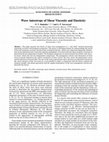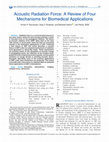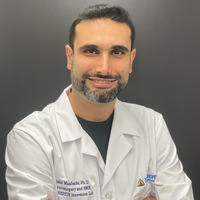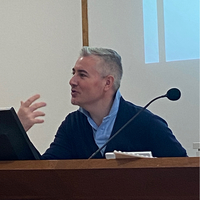Papers by Armen Sarvazyan

Acoustical Physics, 2014
The paper presents the theory of shear wave propagation in a "soft solid" material possessing ani... more The paper presents the theory of shear wave propagation in a "soft solid" material possessing anisotropy of elastic and dissipative properties. The theory is developed mainly for understanding the nature of the low frequency acoustic characteristics of skeletal muscles, which carry important diagnostic informa tion on the functional state of muscles and their pathologies. It is shown that the shear elasticity of muscles is determined by two independent moduli. The dissipative properties are determined by the fourth rank viscos ity tensor, which also has two independent components. The propagation velocity and attenuation of shear waves in muscle depend on the relative orientation of three vectors: the wave vector, the polarization vector, and the direction of muscle fiber. For one of the many experiments where attention was distinctly focused on the vector character of the wave process, it was possible to make a comparison with the theory, estimate the elasticity moduli, and obtain agreement with the angular dependence of the wave propagation velocity pre dicted by the theory.

Journal of the Acoustical Society of America, 2015
One of the major (but the least studied!) functions of skeletal muscle is protecting the skeletal... more One of the major (but the least studied!) functions of skeletal muscle is protecting the skeletal system from external impacts by absorbing and redistributing the energy of mechanical shock in time and space. During muscle contraction, its elasticity modulus is greatly increased, which partly unloads adjacent bones and skeletal joints. Muscle viscosity is also greatly increased helping to absorb and dissipate dangerous shocks. Elasticity and viscosity data may be obtained using the measurement of shear wave velocity and attenuation. In this study, we investigated changes in the velocity and attenuation of shear acoustic waves in an anisotropic tissue phantom mimicking skeletal muscle under different level of tension of the fibers imbedded in the phantom. Stretching the fibers simulates the muscle contraction. It is shown that both velocity and attenuation of shear waves propagating along the fibers significantly increase with fiber tension while they are negligibly affected in the c...

IEEE Transactions on Ultrasonics Ferroelectrics and Frequency Control, Nov 1, 2021
Radiation force is a universal phenomenon in any wave motion where the wave energy produces a sta... more Radiation force is a universal phenomenon in any wave motion where the wave energy produces a static or transient force on the propagation medium. The theory of acoustic radiation force (ARF) dates back to the early 19th century. In recent years, there has been an increasing interest in the biomedical applications of ARF. Following a brief history of ARF, this article describes a concise theory of ARF under four physical mechanisms of radiation force generation in tissue-like media. These mechanisms are primarily based on the dissipation of acoustic energy of propagating waves, the reflection of the incident wave, gradients of the compressional wave speeds, and the spatial variations of energy density in standing acoustic waves. Examples describing some of the practical applications of ARF under each mechanism are presented. This article concludes with a discussion on selected ideas for potential future applications of ARF in biomedicine.

The Journal of the Acoustical Society of America, 1996
Most of the biomedical applications of ultrasound are based on the use of focused ultrasound with... more Most of the biomedical applications of ultrasound are based on the use of focused ultrasound with a high concentration of energy in the focal region and, respectively, with significant contribution of nonlinear phenomena in ultrasonic bioeffects. The main objective of the current paper is to provide a clear understanding of basic phenomena in nonlinear acoustic fields of focused ultrasound, and to derive simplified equations that would enable physicists and engineers to optimize parameters of biomedical devices for particular applications. Special attention is paid to the contribution of acoustic nonlinearity to the second-order quantities, such as radiation pressure and temperature rise in ultrasonic fields in tissues. Based on asymptotic methods recently developed in nonlinear acoustics, analytical solutions of the equations for the radiation force induced in a dissipative medium are considered. The relationships between parameters of acoustic field and characteristics of biologic...

Acoustical Imaging, 1995
ABSTRACT Elasticity imaging is based on two processes. The first is the evaluation of the mechani... more ABSTRACT Elasticity imaging is based on two processes. The first is the evaluation of the mechanical response of a stressed tissue using imaging modalities, e.g. ultrasound, magnetic resonance imaging (MRI), computed tomography (CT) scans and Doppler ultrasound. The second step is depiction of the elastic properties of internal tissue structures by mathematical solution of the inverse mechanical problem. The evaluation of elastic properties of tissues has the potential for being an important diagnostic tool in the detection of cancer as well as other injuries and diseases. The success of breast self-examination in conjunction with mammography for detection and continuous monitoring of lesions has resulted in early diagnosis and institution of therapy. Self-examination is based on the manually palpable texture difference of the lesion relative to adjacent tissue and, as such, is limited to lesions located relatively near the skin surface and increased lesion hardness with respect to the surrounding tissue. Imaging of tissue “hardness” should allow more sensitive detection of abnormal structures deeper within tissue. Tissue hardness can actually be quantified in terms of the tissue elastic moduli and may provide good contrast between normal and abnormal tissues based on the large relative variation in shear (or Young’s) elastic modulus.

The Journal of the Acoustical Society of America, 2010
ABSTRACT Thousands of papers on radiation force (RF) and acoustical streaming (AS) have been publ... more ABSTRACT Thousands of papers on radiation force (RF) and acoustical streaming (AS) have been published since Faraday, Rayleigh, and Langevin. There have been more papers on RF in biomedicine published in the last decade than were written in the entire 20th century. Nevertheless, some nonlinear acoustic phenomena significant for engineering and biomedical applications are still misunderstood. The presentation contains discussions regarding frequently occurring inaccuracies and contradictions. In particular, it features three types of nonlinearities which can appear independently. First, equations for RF, which are nonlinear by themselves, can contain the nonlinear modulus of a medium. Second, the nonlinear distortion of the acoustic field, depending on sound intensity and geometric and physical nonlinearities, can govern the RF and AS. Third, hydrodynamic nonlinearity often appears at the development stage of streaming. The latter nonlinearity may be observed in weak acoustic fields if RF acts for a long period of time on a low-viscosity fluid. Evaluations and formulas are given, indicating conditions for separate observation of each type of nonlinearity. Some contradictions existing in the literature are resolved. Experimental data illustrating developed theory are shown.

Acoustical Physics, 2009
ABSTRACT The article is a review of the new dual-frequency method in axial bone quantitative ultr... more ABSTRACT The article is a review of the new dual-frequency method in axial bone quantitative ultrasonometry for assessment of changes in cortical bones in osteoporosis. The method is based on the use of two frequencies for the generation of flexural and longitudinal ultrasonic waves, which opens possibilities for differential diagnostics of changes in various components of the state of the skeletal system, such as cortical layer thickness, porosity, and elastic properties of tissue. The axial scanning and composition of two-dimensional acoustic profiles of bones are carried out with the purpose of using topographic variations in the acoustic properties for diagnostics of the state of a bone. Results of laboratory and clinical tests of Bone UltraSonic Scanner (BUSS) developed in Artann Laboratories on the basis of the stated principles are presented. The sensitivity of measured characteristics to progression of osteoporosis and the detectability of early changes in bones related to this disease are shown.
Current Medical Imaging Reviews, 2012
Mechanical Imaging (MI) is a branch of Elastography. MI differs from conventional ultrasonic and ... more Mechanical Imaging (MI) is a branch of Elastography. MI differs from conventional ultrasonic and MR elastography in that it evaluates soft tissue mechanical structure using stress data rather than dynamic or static strain data. MI closely mimics manual palpation because the MI probe with a force sensor array attached to its tip acts as a palpating finger. MI is intrinsically a threedimensional imaging modality because the surface stress patterns obtained at different levels of tissue compression are defined by three-dimensional mechanical structure of the tissue. This review presents the biomechanical basis of MI and its applications for breast cancer screening, and the differentiation of benign and malignant lesions, the visualization and evaluation of prostate conditions, and for the characterization of vaginal wall elasticity.








Uploads
Papers by Armen Sarvazyan